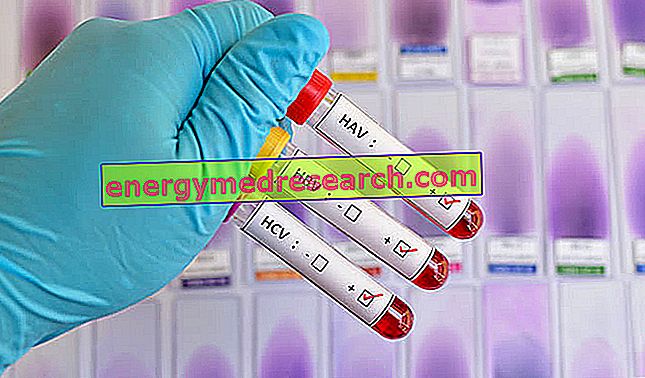To investigate the numerous liver functions, the doctors have at their disposal an array of instrumental and laboratory tests (blood tests), equally rich. In most cases - to go back to a specific morbid condition affecting the liver and at the same time establishing its nature and seriousness - it is necessary to use specific groupings of these tests.
Among the blood tests that investigate the health of the liver we remember the dosage of:
- enzymes of hepatocytic origin (transaminases - AST, ALT - ALP and GGT);
- direct and indirect bilirubin (dosage in urine also important);
- plasma proteins (total amount, albumin and / or globulins);
- coagulation factors (prothrombin time);
- antibodies specific for hepatitis A, hepatitis B, hepatitis D and hepatitis E

Referring the reader to the individual in-depth articles (by clicking on the underlined words in blue), let's briefly summarize the general clinical meaning of these liver tests.
Values liver | Clinical meaning | Normal values |
ALBUMIN | Synthesized by the liver, albumin is the most abundant protein in plasma. Its values decrease in the presence of chronic liver diseases, such as cirrhosis, due to the reduced synthesis. The same result can be had in the presence of chronic renal diseases (nephrotic syndrome), due to the abnormal loss of albumin in the urine, but also in the presence of severe malnutrition, prolonged fasting, protein catabolism and numerous other conditions. For this reason the ability of hepatic protein synthesis is evaluated by preferably dosing other markers, such as coagulation factors. | 3.9 - 5.0 g / dL |
| ALT | Alanine transaminase, more simply ALT, ALAT or SGPT, is an enzyme present in the mitochondria of liver cells (hepatocytes), involved in protein synthesis. When a hepatocyte is damaged it inevitably produces a leakage of this and other enzymes, which increase its concentration in the blood. As a result, ALT blood values increase significantly during acute organ damage, such as during an acute viral hepatitis, chronic hepatitis or an overdose of paracetamol (fulminant hepatitis). | 9 - 60 IU / L |
| AST | Aspartate transaminase (AST), also known as ASAT or SGOT, is another enzyme contained in liver cells; consequently its increase in blood recognizes the same hepatic causes, although it can be traced more easily to cardiac or muscular damage. It is therefore a non-specific index of liver function; its values can be related to those of ALT to trace the nature - hepatic or extra-hepatic - of the increase in these transaminases. If ALT is much more increased than AST, liver damage is plausible, vice versa cardiac. Comparison of these and other enzymes with creatine kinase values can confirm or deny the hepatic origin of the problem. In fact, creatine kinase increases in the presence of a muscle injury, so normal values associated with high ALT values suggest a liver problem. | 10 - 40 IU / L |
| ALP | Alkaline phosphatase (ALP) is an enzyme contained in the cells that line the innermost layer of the intrahepatic bile ducts. Therefore, an increase in ALP values in the blood can result from bile obstructions of various kinds (gallstones), intrahepatic cholestasis or infiltrative liver diseases (for example, a tumor). Its rise is common even in the presence of osee diseases. | 30 - 120 IU / L |
BILIRUBIN TOTAL BILIRUBIN DIRECT | Bilirubin is a degradation product of EME, a key component of hemoglobin in red blood cells. Once synthesized (indirect or unconjugated bilirubin) it is made water-soluble in the liver (direct or conjugated bilirubin), and secreted in bile (which flows into the intestine). An increase in the total fraction with high conjugate fraction high and normal conjugate, can therefore reflect a problem of liver function (cirrhosis, viral hepatitis etc.) or an increased catabolism of red blood cells (haemolytic anemia). In contrast, an increase in the conjugate (direct) fraction may reflect an intra or extrahepatic biliary obstruction problem. Slightly increased indirect bilirubin levels, with all other normal liver function markers, are common in Gilbert's syndrome. The excess of bilirubin in the blood gives the skin and ocular sclerae a yellowish color (jaundice). | TOTAL 0.1-1.2 mg / dL DIRECT 0-0.3 mg / dL |
| GGT | Gamma glutamyl transpeptidase (GGT) is an enzyme involved in hepatic detoxification mechanisms. Its levels increase significantly in ethyl alcohol poisoning (acute or chronic). | 0 to 51 IU / L |
TIME TO PRO THROMBIN | This blood test measures the plasma clotting time; since the liver is the key organ in the synthesis of coagulation proteins, an increase in this range may indicate liver damage. See also INR. | 11 - 13 seconds |
LACTATE Dehydro-Genasi | Lactate dehydrogenase (LDH) is an enzyme found in many tissues of the body, including the liver. It is therefore a highly non-specific index of liver function, and its increase can also, but not necessarily, indicate damage to the liver (in this case, the LDH 4 and LDH5 isoforms increase above all). | - |
EXAMS immuno- LOGIC | In the presence of a suspicion on a possible viral hepatitis, immunological tests can be conducted on the blood sample in order to search for viruses and antibodies against them. The search for auto-antibodies can instead be carried out in the presence of suspicions on possible autoimmune liver diseases, triggered by the presence of abnormal antibodies against the same cells of the body (primary biliary cirrhosis, autoimmune hepatitis, primitive sclerosing cholangitis). |
| RESULTS OF EXAMINATIONS OF LIVER FUNCTIONALITY AND LIVER DISEASES | ||||
| Disease | ALT | AST | GGT | ALP |
| Viral hepatitis | +++ | +++ | ++ | N / + |
| Drug hepatitis | ++ | ++ | ++ | N / + |
| Active chronic hepatitis | ++ | ++ | ++ | ++ |
| Hepatitis due to infectious mononucleosis | ++ | ++ | ++ | N |
| Primary biliary cirrhosis | ++ | ++ | +++ | ++ |
| Alcoholic cirrhosis | N | ++ | +++ | N / + |
| Intrahepatic cholestasis | ++ | ++ | +++ | ++ |
| Extrahepatic cholestasis | ++ | ++ | +++ | +++ |
| Hepatoma (primary malignant tumor of the liver) | N / + | ++ | ++ | ++ |
| Variation of some blood constituents in different pathologies | |||||||
| DISEASE | Bilirubin | Albumin | globulins | ALP | ALT | AST | LDH |
| Primary hepatic carcinoma | N / A | N / D | N / A | DOES | TO | TO | DOES |
| Biliary cirrhosis | N / A | N / D | N / A | DOES | N / A | TO | N / A |
| Acute hepatitis | TO | N | N / A | TO | DOES | DOES | TO |
| Active chronic hepatitis, cirrhosis | N / A | D | TO | TO | TO | TO | N / A |
| Alcoholic hepatitis | TO | D | N / A | TO | TO | TO | N / A |
| Hepatitis due to infectious mononucleosis | N / A | N | N | TO | TO | TO | TO |
| WHERE: N = normal values; A = increased values; D = values decreased; FA = markedly increased values; ALP: alkaline phosphatase; ALT = alanine aminotransferase; AST = aspartate aminotransferase; LDH = lactate dehydrogenase | |||||||
Among the instrumental tests used to investigate liver health, a major role is played by abdominal ultrasound, which exploits the different ability of tissues to reflect the ultrasound emitted by an electric probe. Alternatively, magnetic resonance can be used; both procedures, being released from any emission of ionizing radiation, are absolutely safe for the patient. Sometimes, the diagnostic certainty is obtained by taking a small fragment of liver tissue (frustule, carrot), using a special needle inserted in the abdomen, obviously under ultrasound guidance and under local anesthesia. At other times, a test called endoscopic retrograde colangiopancreatography is used, which consists in the descent of a tube by oral route until reaching the extrahepatic bile ducts. If necessary, this probe also makes it possible to perform therapeutic maneuvers such as the removal of stones or the restoration of the patency of the occluded canals.



